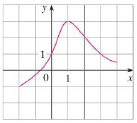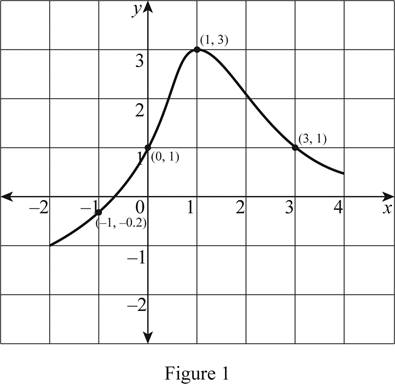
Concept explainers
The graph of a function f is given.
(a) State the value of f(1).
(b) Estimate the value of f(‒1).
(c) For what values of x is f(x) = 1?
(d) Estimate the value of x such that f(x) = 0.
(e) State the domain and range of f.
(f) On what interval is f increasing?

(a)
The value of
Answer to Problem 1E
The value of
Explanation of Solution
Given:
Plot the points in the given graph as shown below in Figure 1.

Calculation:
In Figure.1, x-axis represents the values of x, and y-axis represents the values of
From Figure 1, it is noticeable that the point (1, 3) is plotted.
Therefore, the value of
(b)
The value of
Answer to Problem 1E
The value of
Explanation of Solution
From Figure 1, it is seen that when x = −1 the f(x) is approximately equal to −0.2.
Therefore, the value of
(c)
The value of x if
Answer to Problem 1E
If
Explanation of Solution
From Figure 1, it is it is noticeable that the points (0, 1) and (3, 1) are plotted.
Therefore, when
(d)
The value of x if
Answer to Problem 1E
If
Explanation of Solution
It is seen from the Figure 1 that when f(x) = 0, the value of x is approximately −0.8.
Therefore, when
(e)
The domain and range of f.
Answer to Problem 1E
The domain of f is
Explanation of Solution
Since, the domain of a function is the set of all x values of the graph, the domain is
Since, the range of a function is the set of all y values of the graph, the range of the function is
(f)
The increasing interval of f.
Answer to Problem 1E
The increasing interval of f is
Explanation of Solution
From Figure 1, it is noticeable that the curve is increasing between
Therefore, the increasing interval of f is
Chapter 1 Solutions
Single Variable Calculus: Concepts and Contexts, Enhanced Edition
 Calculus: Early TranscendentalsCalculusISBN:9781285741550Author:James StewartPublisher:Cengage Learning
Calculus: Early TranscendentalsCalculusISBN:9781285741550Author:James StewartPublisher:Cengage Learning Thomas' Calculus (14th Edition)CalculusISBN:9780134438986Author:Joel R. Hass, Christopher E. Heil, Maurice D. WeirPublisher:PEARSON
Thomas' Calculus (14th Edition)CalculusISBN:9780134438986Author:Joel R. Hass, Christopher E. Heil, Maurice D. WeirPublisher:PEARSON Calculus: Early Transcendentals (3rd Edition)CalculusISBN:9780134763644Author:William L. Briggs, Lyle Cochran, Bernard Gillett, Eric SchulzPublisher:PEARSON
Calculus: Early Transcendentals (3rd Edition)CalculusISBN:9780134763644Author:William L. Briggs, Lyle Cochran, Bernard Gillett, Eric SchulzPublisher:PEARSON Calculus: Early TranscendentalsCalculusISBN:9781319050740Author:Jon Rogawski, Colin Adams, Robert FranzosaPublisher:W. H. Freeman
Calculus: Early TranscendentalsCalculusISBN:9781319050740Author:Jon Rogawski, Colin Adams, Robert FranzosaPublisher:W. H. Freeman
 Calculus: Early Transcendental FunctionsCalculusISBN:9781337552516Author:Ron Larson, Bruce H. EdwardsPublisher:Cengage Learning
Calculus: Early Transcendental FunctionsCalculusISBN:9781337552516Author:Ron Larson, Bruce H. EdwardsPublisher:Cengage Learning





